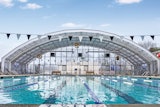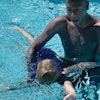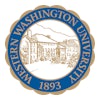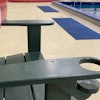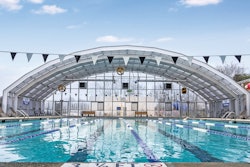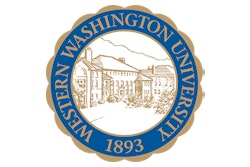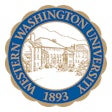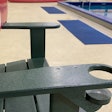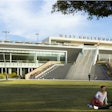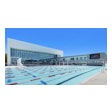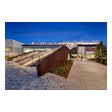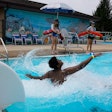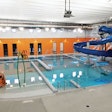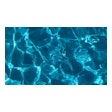Mike Pollocoff, the village manager in Pleasant Prairie, Wis., takes a lot of pride in never having had to levy a tax to pay capital costs or debt service on his 305,000-square-foot recreation center, the RecPlex, through its construction and two additions.
 Kiosks along a lakeside path explain the geothermal technology that heats pool water and controls air temperature in the new RecPlex Aqua Arena. (Photos courtesy of Partners in Design Architects)
Kiosks along a lakeside path explain the geothermal technology that heats pool water and controls air temperature in the new RecPlex Aqua Arena. (Photos courtesy of Partners in Design Architects)Mike Pollocoff, the village manager in Pleasant Prairie, Wis., takes a lot of pride in never having had to levy a tax to pay capital costs or debt service on his 305,000-square-foot recreation center, the RecPlex, through its construction and two additions. "We've been in business 10 years now," he says, "and we've never even come close."
But few things have brought a bigger thrill than the $56,563 check he received at the end of last year from Wisconsin Focus On Energy, a program that, with the help of various state and private organizations, helps residents and business owners install energy-efficient and renewable-energy equipment. The check, which arrived six months after the June 2010 dedication of the 42,000-square-foot RecPlex Aqua Arena addition, and after FOE inspectors verified installation of required equipment, helped pay for the project's most intriguing energy-efficient component, a geothermal system that uses neighboring Lake Andrea to both heat the pool water and cool the air in the natatorium. In its own way, the FOE grant made a bigger splash than the $1.8 million in interest-free conservation bonds for which the project qualified through the American Recovery and Reinvestment Act of 2009. Pollocoff calls the geothermal system the most visible aspect of the village's commitment to energy efficiency.
"A trail wraps around for people to walk around the lake, and we put up kiosks explaining what the temperature is in the lake, what the temperature is in the pool and what we're doing to get that temperature up or the air temperature down," he says, adding that the environmental aspect has garnered an extremely positive reaction from the community. "When we started building this, it was at probably the toughest time for the economy; doing something that was energy efficient and saving money was welcomed."
Myriad federal grant programs offer consumers and businesses information and financial incentives to promote energy efficiency, from the Tax Incentives Assistance Project to the U.S. Environmental Protection Agency and U.S. Department of Energy's Energy Star program. Wisconsin Focus on Energy is but one of many state programs designed to do the same.
Pollocoff's road to the modest but significant FOE windfall began with a conversation with a RecPlex member who mentioned that the lake could be used to heat pool water. Village planners, who already were keen on renewable energy and energy efficiency, turned to architect Tom O'Connell of Partners In Design in nearby Kenosha to explore that option. Pollocoff had had previous experience with FOE, while O'Connell had only seen FOE's mass mailings. When the planning team submitted preliminary plans to FOE, they got back 10 recommendations that, if implemented, held the potential to lop 45 percent off the pool's energy usage.
"Given what 50-meter pools cost to heat, 45 percent is significant," says Pollocoff. "We could get some money rounded up to help build this thing" - the village's seed money for the $12.7 million pool addition was in the form of an $8 million corporate gift - "but if your operating costs are really high, it ends up being an anvil around your neck. The fact that it sat on a lake that we could use as a heat pump really made it possible."
"We've done other LEED projects, but this was truly a unique opportunity," says O'Connell. "In some ways, how a lot of building types get LEED-certified is almost formulaic. This one was a little different in terms of the creative process, because you can't just look at case studies of other pools that have used a lake for geothermal purposes to increase their energy efficiency. It started out as, 'Let's save money on heating water,' and then it kind of ballooned into upgrades in insulation, motor efficiencies and glass."
The project summary made all this explicit, listing as qualifying measures extra wall and roof insulation, window shading, proper pool water circulation pump motors, an HVAC system that uses exhaust heat from the air-conditioning unit to heat the pool, an air-to-air heat exchanger that heats 19,000 cubic feet per minute of outside air for the pool area, an efficient central heat pump to heat the pool area, and a traditional water-to-air heat pump to heat support spaces.
FOE estimates annual energy usage and energy-cost savings for each of the project's energy-efficient components, and although the geothermal system represents a negative kilowatt-hour value of 62,959 in terms of electricity usage, FOE says that the system "uses electricity at a more efficient rate, resulting in substantial natural gas savings that outweigh the increase in electricity." In all, FOE estimates the addition's annual savings in natural gas at 97,638 therms, or $73,256.
"Focus On Energy did a payback analysis for each energy item, and some were a little longer-term, like the added insulation in the roof, the added insulation in the wall panels, the triple glazing on the windows," says O'Connell. "But things like the geothermal system and an energy recovery system were incredibly short-term, like a two-year payback."
Pollocoff says the energy-efficient equipment added about a half-million dollars to the project cost, well worth the effect it will have on future costs. Overall, he says, the addition will achieve complete payback in five and a half years. The initial plans projected annual energy costs at $200,000, according to O'Connell, a figure that he says will be halved by the FOE recommendations.
"A good part of the improvements is already paid off," Pollocoff says. "It's a gift that keeps on giving."
Natural Resources
Project managers looking to take advantage of state energy-efficiency grants would be well advised to start with the Database of State Incentives for Renewables & Efficiency (DSIRE), a ready resource for finding incentive programs. Mike Pollocoff, the village manager in Pleasant Prairie, Wis., notes that even in states where no program yet exists, local utilities would rather incentivize project managers to save energy than build more capacity. Start by calculating operating expenses of the finished product, he says, and "if there isn't a program in your state like Focus On Energy, approach the utility that services your area and make the pitch." For federal grants and low-interest financing opportunities, Pollocoff suggests staying abreast of the International City/County Management Association (ICMA) and the Government Finance Officers Association (GFOA).
Other resources include:









